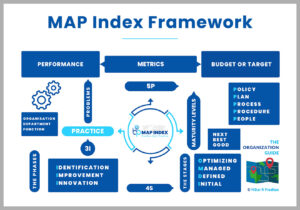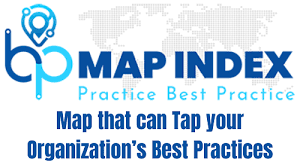Innovation and best practices can be sown throughout an organization but only when they fall on fertile ground — Marcus Buckingham
Best practices, best practices everywhere but not a single one practice is getting followed. Organizations have tried and failed. Organizations want but not getting it. Not about availability but about getting it done. There is no dearth of best practices. Many organizations have implemented and benefited from best practices. The basket of best practices is available out in the open market. Many are even available freely. It so appears that any organization can take those best practices and make their organization the best by using them.
Sounds so Simple but Hard to Listen!!!
But things simply don’t happen that way…
There is so much in between to be done to derive the best. The qualification of best to a practice is not cosmetic in nature rather is comprehension in character. Best practices have a strong character and only then we can develop a stronger personality. Best practices personality is built on strong character and grown on stronger value system.
Just because the employee hiring practices are the best in few organizations that we know, we cannot emulate their best practices and become the best in the business of attracting talent and retaining them. There are many facets to being the best in hiring practices. The different means used for sourcing candidates to the methods employed for assessing them to mechanism used for verifying their claims and credentials. For instance, in the assessment area are we fully factoring in the cultural fitment aspect?
Many organizations have miserably failed in making those best practices the best in their business. There are reasons behind it. These best practices have a context to which it makes proper sense. These best practices have a backdrop to culture on which it prospers. These best practices have dedicated efforts put in overtime and concerted working from the managers. These best practices have a strong commitment from the business leaders. These best practices have a firm foundation on which they are able to grow and sustain.
When we look at knowledge as an artifact we think of the explicit part and grossly miss out on the significant role played by the tacit knowledge. It is not easy to extract and transfer such knowledge. It is the tacit that sets the best from the rest. When we look at data as a fact we get engaged with the quantitative part and largely miss out on the key role played by the qualitative analysis. It is the qualitative that keeps the best from the rest.
All these critical things and clinical workings are much needed to make a practice become the best. All these changes need to be affected and managed well to even make this imported best practices to survive and strive.
Just because the inventory management practices is best in few organizations that we know we can get those best practices and make our organization the best. The best part of the inventory management could comprise of various techniques and methods like JIT to FIFO. Best practices are not available in a plug and play mode in companies like computer machines. We have to customize these best practices and keep tuning to suit our environment.
Organizations are different by nature. There are multiple layers to be set in place and deeper nuances to be considered in building a good organization. Organizations are not like constructing a physical building where we follow the steps of construction engineering and we have the house constructed. Organizations are not like buildings where we simply follow the process and we have the house constructed as specified.
Organizations are much more different and are like living organisms. This evolves with time and the evolution process needs constant nurturing. Nobody can replicate or replace the factor of time. Time has to be dedicated for subtle aspects of the organization to properly settle and shape up. Time is not something that comes bundled with best practices. The time needed to grow and nurture a practice to become best practices depends on the very nature of the organization.
The nature of organization intrinsically revolves around the culture. The culture revolves around people. An animated and open environment fosters newer ideas and nurtures them better. A dreary and close environment will negate new ideas and keep dragging. We cannot ignore the drag factor in organization. The inertia and resistance are at constant play. The culture is not something we can import and simply implant.
Best practices needs time and space to settle things. We have to permit the time. We have to create the space. Just by giving ample financial resources will not serve the purpose. There are these other things predominantly intangible in nature needs serious nurturing. We know the significance of time and space in the universe we live.
Albert Einstein discovered the connection and established the gravitational phenomenon termed as space-time continuum. The importance of space and time in whatever we do and how we do have a strong bearing and we have to put it in proper place. Unfortunately, these nuanced facets are not understood properly and let alone getting the appreciation needed. Without creating a strong foundation and setting right the fundamentals, no organization can practice the best practices. The foundation of an organization is premised on the core values being put in place and the culture that is being nurtured.
Are the fundamental principles of doing business being followed?
Best practices are driven by certain set of strong principles. Best practices are set in a conducive and creative environment. Best practices are made as the best by the people’s commitment. Best practices are made the best by the determination and drive set in by the management. Best practices are made the best by the passion and vision of leader at the helm. These are things that cannot be captured in complete exactness with every detail in terms of steps, forms and templates. Something that we can follow religiously and if followed rigorously we can come close to emulating the best practices.
Best practices comprises not just the crafted tools, specific techniques, tailored processes to matured methods but the holistic craftsmanship – the hidden art behind the stated science of running an organization. We have to discover the hidden ways and we have to innovate and do things differently. Not just do different things but do things differently. There is a subtle difference that is striking; knowing how to delicately but decisively play the interplay makes such a huge difference.
Best practices comprises of both the art and science of doing things. Best practices have both tangible facets and intangible aspects. Best practices have both known features and unknown facets. Best practices encompass both explicit and tacit knowledge. Best practices need the workings of both nature and nurturing. Best practices need both the time and space to get the gravity. The documented best practices capture a smaller part but the bigger part remains outside the definition.
Just by following the formal definition we can never reach the destination of best practices. However, strictly and stringently we intend to follow we will never practice best practice. The documented best practices are easily available but are never easy to practice in a different environment. It is the hard fact of practicing best practices. We need to consciously create the opportune environment and keep on putting concerted efforts to get it well crafted. Best practices cannot be simply imported and implanted but have to be constantly created and crafted…hence it is hard to adapt or adopt best practices just like that without doing the needful.












